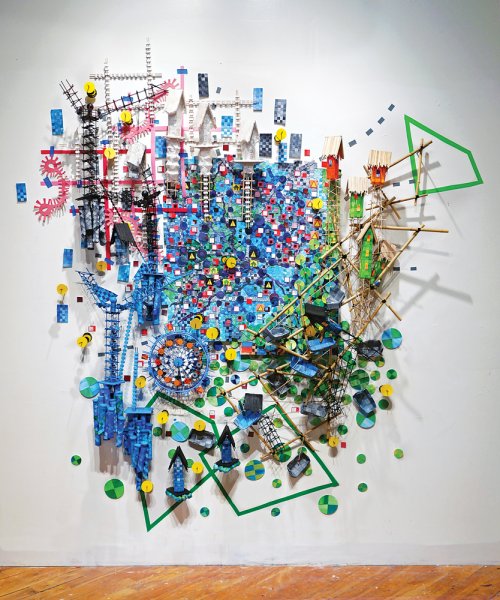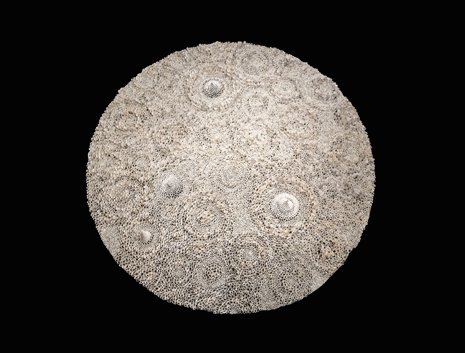In Focus
In Focus
How have exhibiting organizations used craft to engage with America’s concerns in 2019? How have they explored contemporary modes of thinking and making? We asked four representatives to weigh in: Brigitte Martin, executive director of Boston’s Society of Arts + Crafts; Jill Ahlberg Yohe, PhD, associate curator of Native American Art at the Minneapolis Institute of Art; Kathryn Hall, curator at the Houston Center for Contemporary Craft; and Ariel Zaccheo, assistant curator at the Museum of Craft and Design in San Francisco. Their answers come in the form of thought-provoking works on view this past year, each a starting point for a more complex engagement with American values and American life right now.
But the task wasn’t easy for them. “Choosing just one item from the diverse array of objects we present is like having to choose which of your children is your favorite,” Martin says. “You love them all, for different reasons.”
The exhibition “Child’s Play,” on view until January 18, is somewhat of a departure for the Society of Arts + Craft, which is newly located in a burgeoning area of Boston, the Seaport District. For those not familiar with Boston, the Seaport is changing rapidly. Just a decade ago, the now lively area was nothing but a mudflat; today, new high-rises and great restaurants spring up almost weekly. I wanted to curate an exhibition that embraces the joyous and fun atmosphere of the Seaport and to show work – a gamut of artful toys, games, and kinetics – that not only speaks to all ages but also grabs our new audience’s interest.
The exhibition explores markers of childhood through the lens of an adult. But while play and whimsy are definitely at the show’s heart, sinister undertones and political commentary underlie some of the works, serving as a reminder that childhood is not the protected bastion it was once thought to be.
Brett Kern’s Inflatable Stegosaurus fits the show’s theme perfectly. The artist expertly crafts inflatable dinosaurs and other toys that are so realistic, they are practically indistinguishable from their plastic counterparts, tell-tale wrinkles and all. On closer inspection, however, the sculptures reveal that they are in fact crafted entirely from clay – emphasizing the differences that often exist between one’s perception and reality. ~Brigitte Martin, executive director, Society of Arts + Crafts, Boston
Last summer, the Minneapolis Institute of Art debuted “Hearts of Our People: Native Women Artists,” the first major exhibition dedicated to Native women artists across time and place. Co-curator Teri Greeves, a colleague, a master beadwork artist, and a member of the Kiowa Nation, and I began the process of creating the show. At the onset, we recognized an exhibition that honors the achievements and multiplicity of Native women artists – long the creative force behind Native art – required an approach that included many perspectives.
An Exhibition Advisory Board, comprised of 19 Native women artists and scholars (both Native and non-Native) from across what is now the US and Canada, contributed knowledge and expertise essential to tell this story, which spans more than 1,000 years.
Lisa Telford’s PochaHaida (a reference to Pocahontas and the Haida people of the Canadian Queen Charlotte Islands and Alaska) embodies the exhibition. Woven of pounded red and yellow cedar bark that Telford (Git’ans Git’anee Haida) gathered and processed herself, the dress is a twist and a commentary on the one Pocahontas wears in the Disney movie of the same name. It’s also a reinterpretation of the Haida weaving techniques Telford is trained in. Customarily, cedar garments use sea otter fur; in this case, however, Telford opted for faux fur along the neckline, for a “commercialized Haida woman.” The piece critiques the commercialization of images and stories of Native women and honors the power Pocahontas held in her Powhatan community as a translator, ambassador, and leader. With this dress, Telford reclaims her power. ~Jill Ahlberg Yohe, PhD, associate curator of Native American Art, Minneapolis Institute of Art
It has been just over two years since Hurricane Harvey made landfall, yet Houstonians are still dealing with the loss and impact of the storm and an increased risk of flooding due to rising water levels in and around the Gulf Coast.
During Harvey, the 911 emergency system was overloaded, and many people turned to social media for help in getting rescued. In Harvey’s Twitter SOS, Boston artist Nathalie Miebach uses basketry techniques to weave together two narratives: the science of the storm (weather data) and the human experience (messages gathered from Twitter). With symbols of boats floating over a sea of information outlining rising water levels, road closures, and areas with high concentrations of social media messages, the installation captures the chaos brought on by a natural disaster and the search and rescue efforts coordinated by citizens.
The piece is one of several in Miebach’s solo exhibition “The Water Line,” on view at the Houston Center for Contemporary Craft through January 5, that looks at the drastically different response-and-recovery narratives of three hurricanes of 2017: Harvey, Irma, and Maria. Miebach’s use of basketry techniques provides a nuanced approach to data visualization that presents us with the harsh realities of these catastrophic events and how one region of the world has been affected by rising temperatures. She beautifully illustrates how craft can be used to interpret case studies in a tangible way that promotes conversation within our communities about climate change. ~Kathryn Hall, curator, Houston Center for Contemporary Craft
In “Material Domestication,” a group exhibition curated by Elizabeth Kozlowski, Jamie Bardsley’s Palm Prints transformed a single, repetitive motion into a massive installation. Starting in 2010, the Colorado artist spent a year and a half folding porcelain into droplets in the palm of her hand. After countless hours forming thousands of pieces, she fired them, meticulously sorted them by size and clay body, and packed them up. Though the output was massive, almost every piece shows her thumbprint, a mark of the time she invested in their creation.
“Our experience of time is much like water,” Bardsley says, “constantly shifting and changing.” So, too, Palm Prints has changed. In past iterations, the installation took the shape of a long rectangle, a square, and even a droplet, a meta-reflection of Bardsley’s water metaphor.
For the Museum of Craft and Design, Bardsley sat cross-legged on our unforgiving concrete floor over the course of five days (while she was seven months pregnant, no less) and carefully considered the placement of each piece within a 10-foot-diameter circle. The end result featured rippled mandalas made from tiny clay folds, with slight variations in hue where different clay bodies were used. The oscillation between the individual components and the installation as a whole was like waves lapping at the shore. At the end of the exhibition, the thousands of pieces were broken down, sorted, and packed up again to become part of a different system. ~Ariel Zaccheo, assistant curator, Museum of Craft and Design, San Francisco



